
Real
World Weather Testing
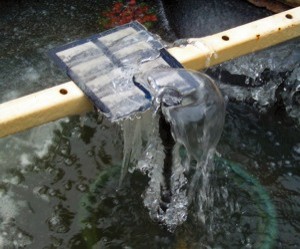 An
imaged test plate (special blue/black chromic oxide) and
two imaged test medallions were placed outside. The medallions
were not subject to running water except for rain. The
test plate was placed under a running fountain re-circulating
particulate laden, brackish water (see effective GPH below).
The test plate and medallions were exposed to constant
sun (UV) during the day. Part of the test plate was covered
with clear tape to protect a portion of the surface (images
and background).
An
imaged test plate (special blue/black chromic oxide) and
two imaged test medallions were placed outside. The medallions
were not subject to running water except for rain. The
test plate was placed under a running fountain re-circulating
particulate laden, brackish water (see effective GPH below).
The test plate and medallions were exposed to constant
sun (UV) during the day. Part of the test plate was covered
with clear tape to protect a portion of the surface (images
and background).
The
fountain head flow radius was adjusted to cover approximately
one sq. ft. The fountain head flow rate was tested using
a one gallon container positioned where the water would fall
on ½ the test plate. An accurate flow rate of 81.8
GPH (gallons per hour) was recorded. 88.1 GPH translates
to 169.42 inches of simulated hard rainfall per hour based
on the fact that one inch of rainfall produces .52 gallons
of water per square foot.
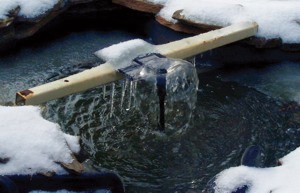 New
Orleans, a city with one of the highest rainfall rates in
the country, receives 60 inches per year. That would mean
our water flow rate for one hour would equal 2.82 years of
rainfall in New Orleans. We ran our test continually for
365 days or 8,760 hours. 8,760 hours x 2.82 years = 24,703.2
years of simulated rainfall based on 60 inches per year.
Keep in mind that rainfall does not contain
the particulate matter re-circulated in this test. This water
was used to see if the images or coating would be eroded
under constant small particle bombardment.
New
Orleans, a city with one of the highest rainfall rates in
the country, receives 60 inches per year. That would mean
our water flow rate for one hour would equal 2.82 years of
rainfall in New Orleans. We ran our test continually for
365 days or 8,760 hours. 8,760 hours x 2.82 years = 24,703.2
years of simulated rainfall based on 60 inches per year.
Keep in mind that rainfall does not contain
the particulate matter re-circulated in this test. This water
was used to see if the images or coating would be eroded
under constant small particle bombardment.
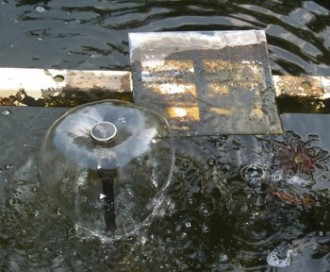 Where
water continually ran over the test plate there was no appreciable
change in color or definition of the images in 8,760 continuous
hours. Where the water hit only during a rain (top of the
test plate) a build up of a very hard film occurred that
was not attacked by mineral spirits, heavy duty detergents,
xylene, or peroxide (no out gassing observed). 20% by weight
NaOH was used to remove the film build upon completion of
the test. No apparent change to the images was observed.
Extensive algae build up occurred at times on bottom half
of the test plate where the water was constantly running.
This was removed periodically with soap using a soft scrub
brush. The pieces experienced temperatures ranging from 100
degrees F. to 0 degree F. along with snow and ice. The pieces
were outdoors in direct sunlight. No UV degradation to the
oxide coating was observed. No film buildup or UV degradation
was observed on the medallions.
Where
water continually ran over the test plate there was no appreciable
change in color or definition of the images in 8,760 continuous
hours. Where the water hit only during a rain (top of the
test plate) a build up of a very hard film occurred that
was not attacked by mineral spirits, heavy duty detergents,
xylene, or peroxide (no out gassing observed). 20% by weight
NaOH was used to remove the film build upon completion of
the test. No apparent change to the images was observed.
Extensive algae build up occurred at times on bottom half
of the test plate where the water was constantly running.
This was removed periodically with soap using a soft scrub
brush. The pieces experienced temperatures ranging from 100
degrees F. to 0 degree F. along with snow and ice. The pieces
were outdoors in direct sunlight. No UV degradation to the
oxide coating was observed. No film buildup or UV degradation
was observed on the medallions.
Please
keep one thing in mind.
Due to the complexity of the production process each etching
of the same subject
matter will be slightly different.
This is due to many factors. For instance, for the weather
test we used two 8” x 8” chromic oxide stainless
steel plates on which we imaged eight train photos, each
rendered a little differently for lpi and dpi. The same
film tool was used to produce each plate, but the
results were slightly different from plate to plate. They
both looked very good, but we could see subtle differences.
The three photos below show the results after the weather
test. The top image was photographed from our control plate.
It was not subjected to any weather testing.
The second image was photographed from our weather tested
plate. Both images look good. They are just a little different.
Upon close inspection no differences
in image definition or UV degradation appeared on the test
plate image when compared to the section we had taped before
the test began. The tape was still intact after 365 days. No water
or particulate matter got under the tape. The tape was
removed and the two halves of the image compared. No discernable
difference was observed.
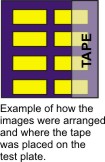 |
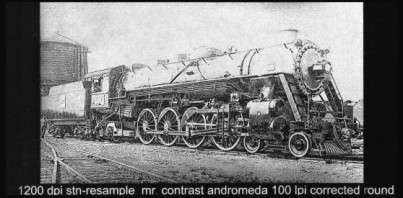
Image taken from
control plate
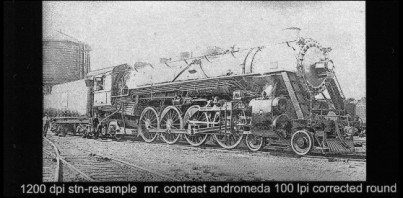
Image taken from weather tested plate
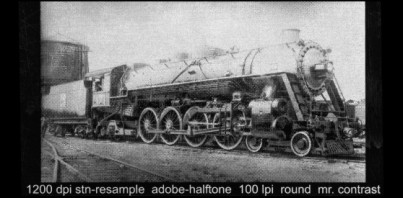
|
This
was a different image on the test plate, but the right 1/3
of the 8” x 8” test plate was taped (right half
of the train image just above). No running water ever touched
that portion. The sunlight’s UV could still penetrate.